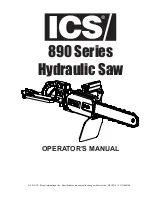
Bevel Cutting
Warning!
Ensure the mitre table lock knob (25) is tight before making a cut.
Failure to do so may result in the rotating mitre table (23) moving during
operation and cause serious personal injury.
A bevel cut is made by cutting across the grain of
wood with the blade (10) angled to the rotating mitre
table (23). The mitre scale (27) is set to 0° and the
blade (10) can be set at an angle between 0° and 45°
(Fig. 20).
1. Ensure the cutting head (4) is raised . If the head
locking pin (5) is locked in place, push down on the
operating handle (7) pull the head locking pin (5) and
gently raise the cutting head (4).
2. Loosen the mitre table lock knob (25) by turning in a clockwise direction,
rotate the mitre table until the pointer aligns with 0° on the mitre scale (27).
3. Tighten the mitre table lock knob (25) by turning in a clockwise direction.
4. Loosen the bevel lock knob (13) and move the
cutting head (4) to the left to the desired bevel
angle as shown on the bevel angle indicator (12)
(Fig. 21).
5. Tighten the bevel lock knob (13) by turning in a
clockwise direction
6. Place the workpiece flat on the rotating mitre
table (23) with one edge securely against the rear
fence (17). If the workpiece is warped, ensure the convex side is against the
rear fence (17).
7. When cutting long pieces of timber, support the opposite end of the timber
with the side support bars (19), a roller stand or a work surface (bench) that is
level with the rotating mitre table (23).
8. Before turning the Mitre Saw on, perform a dry (test) run of the cutting operation
to check that there are no problems and everything is correctly adjusted.
NOTE:
Before performing a cut, ensure the blade (10) is at full speed. Failure
to do this will cause the blade (10) to become blunt and cause the blade to
lock-up.
9. Turn on the Mitre Saw, wait for the blade (10) to reach full speed and then
lower the cutting head (4) so the blade (10) starts cutting the workpiece.
10. Release the on/off switch (8) when the cut is complete and allow the blade (10)
to stop rotating before raising the cutting head (4).
OPERATION (cont.)
13
Fig. 21
Fig. 20










































